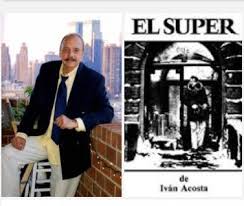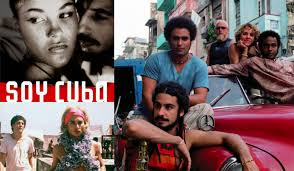 ALGUNAS PELÍCULAS CUBANAS DESDE EL EXILIO.
ALGUNAS PELÍCULAS CUBANAS DESDE EL EXILIO.
Después del triunfo de la Revolución Cubana en 1959, los cubanos que estaban ideológicamente incómodos con el nuevo gobierno revolucionario se dirigieron a los Estados Unidos, donde se establecieron en comunidades concentradas formadas por otros cubanos en el sur de Florida, Nueva York, California, y Nueva Jersey. A diferencia de los inmigrantes tradicionales que optaron por abandonar la patria en busca de una mejor forma de vida en un nuevo lugar, la mayoría de estos cubanos se consideran exiliados forzados a abandonar su patria por circunstancias políticas o económicas.
Debido a que continúan considerándose cubanos incluso después de décadas en los Estados Unidos, es apropiado hablar de ellos como parte de una diáspora cubana que los vincula emocional y psicológicamente a la isla. Más de dos millones de cubanos han abandonado Cuba desde 1959 en diferentes oleadas de inmigración. Entre ellos se encuentran directores, técnicos y actores talentosos que se establecieron en los Estados Unidos, América Latina o Europa, en busca de trabajo y espacio creativo en el campo del cine.
Orlando Jiménez Leal, uno de los cineastas de exilio más conocidos, produjo ‘El Super’ (1979), la primera película de ficción del exilio cubano, dirigida por Jiménez Leal y su joven cuñado, Leon Ichaso. Basado en una obra de teatro de Ivan Acosta, la película se distribuyó ampliamente en los EE. UU. Y ganó premios en festivales de cine en Manheim, Biarritz y Venecia. La película examina el trauma de la clase media cubana, mostrándoles desplazados de su vida anterior e incapaces de adaptarse a las nuevas circunstancias. También destaca los conflictos generacionales entre los padres nacidos en Cuba y sus hijos adolescentes que han sido criados en los Estados Unidos y rechazan la tradición a favor del estilo de vida estadounidense.
Jiménez Leal realizó películas documentales como ‘The Other Cuba’ (1983) y ‘Improper Conduct’ (1984) en colaboración con Néstor Almendros. Conducta impropia es una película muy controvertida que trata sobre el tratamiento de los homosexuales en Cuba. ‘La otra Cuba’ es una amarga denuncia de la Revolución contada desde el punto de vista de la comunidad exiliada. La fuerte postura anticastrista del director dio voz a la creciente comunidad de exiliados políticos cubanos en los Estados Unidos en la década de 1980.
La película más conocida de Leon Ichaso en los Estados Unidos es ‘Bitter Sugar’ (1996), una película de ficción que critica fuertemente la vida en la Cuba posrevolucionaria. Muestra la desilusión de un joven comunista y su novia, quienes son empujados al punto de ruptura por una sociedad represiva. En tono y tema, es similar al ‘Guaguasí’ de Jorge Ulla (1982), que tuvo menos distribución en los Estados Unidos. Guaguasí retrata a un hombre simple del campo que es brutalizado por sus experiencias con el gobierno revolucionario en Cuba. La actitud reaccionaria de directores como Ulla, Ichazo, Almendros y Jiménez Leal los ha convertido en los portavoces cinematográficos de los cubanoamericanos que creen que Fidel Castro es personalmente responsable de los cambios negativos que se han producido en Cuba desde 1959.
http://youtu.be/Vq9QPL206BQ
Un tema importante en el cine de la diáspora cubana es el ir y venir de las personas en el exilio, y el difícil proceso de adaptación a una nueva cultura. Iván Acosta realizó la película ‘Amigos’ (1986) para mostrar la dolorosa existencia bicultural de los cubanoamericanos que viven en Miami. Aunque es una película de bajo presupuesto, hace un trabajo efectivo al capturar los problemas de la generación más joven de cubanoamericanos que están divididos entre el deseo de encajar y la presión de mantener la tradición. ‘Lejanía’ (1985) de Jesús Díaz es la primera película que aborda el tema de los exiliados cubanos que regresan a la isla para visitar a sus familiares. ‘Cercanía’ (2008) de Rolando Díaz, hermano de Jesús, muestra una reciente llegada de Cuba que intenta reconciliarse con su familia en Miami después de décadas de diferencia.
En lugar de abordar temas políticos de forma directa, estas películas se centran en cuestiones personales relacionadas con la adaptación y el choque cultural. ‘Honey for Oshún’ (2001) de Humberto Solás, un director cubano que permaneció en Cuba, aborda el choque entre los cubanoamericanos que regresan a la isla y los que nunca se fueron. Insinúa que la reconciliación es posible, siempre y cuando los que regresen estén dispuestos a aceptar a Cuba en sus propios términos y no forzar una ideología capitalista sobre el pueblo cubano.
En Cuba, las películas hechas por cubanoamericanos o cubanos en el exilio no están ampliamente distribuidas o son bien conocidas, en parte porque las películas tratan la Revolución en una luz negativa, pero también porque los cubanos en la isla disputan la noción de una diáspora cubana y Creemos que quienes viven en el exilio ya no representan la realidad cubana bajo una luz auténtica. Consideran que los directores que experimentan la vida fuera de Cuba representan a Cuba a través de una lente distorsionada y que las películas que hacen son en gran parte obras de propaganda. Tenemos que darle una buena calificación a la película “La ciudad perdida” con Andy García y diferentes actores de Cuba y Estados Unidos.
Muchos actores cubanos importantes ahora viven en el exilio. Entre ellos se encuentran César Évora, Anabel Leal, Reinaldo Cruz, Francisco Gattorno, Tomás Millán, William Márquez, Orestes Matacena, Isabel Moreno y muchos más. Los actores cubanoamericanos que nacieron en Cuba pero crecieron en los Estados Unidos incluyen a Andy García, Steven Bauer, William Levy, Tony Plana y muchos más.
 SOME CUBAN FILMS IN THE DIASPORA.
SOME CUBAN FILMS IN THE DIASPORA.
After the triumph of the Cuban Revolution in 1959, Cubans who were ideologically ill at ease with the new revolutionary government made their way to the United States, where they settled in concentrated communities made up of other Cubans in South Florida, New York, California, and New Jersey. Unlike traditional immigrants who chose to leave the homeland behind in search of a better way of life in a new place, most of these Cubans consider themselves exiles forced out of their homeland by political or economic circumstances.
Because they continue to think of themselves as Cuban even after decades in the United States, it’s appropriate to talk about them as part of a Cuban diaspora that links them emotionally and psychologically to the island. Over two million Cubans have left Cuba since 1959 in different waves of immigration. Among those are talented directors, technicians, and actors who settled in the USA, Latin America, or Europe, in search of work and creative space in the field of cinema.
Orlando Jiménez Leal, one of the best-known exile filmmakers, produced ‘El Super’ (1979), the first Cuban exile fictional film, directed by Jiménez Leal and his young brother-in-law, Leon Ichaso. Based on a play by Ivan Acosta, the film was broadly distributed in the U.S. and won awards at film festivals in Manheim, Biarritz, and Venice. The film examines the trauma of the Cuban middle class, showing them as displaced from their former life and unable to adapt to new circumstances. It also highlights generational conflicts between Cuban-born parents and their teenage children who have been raised in the U.S. and reject tradition in favor of the American way of life.
Jiménez Leal went on to make documentary films such as ‘The Other Cuba’ (1983) and ‘Improper Conduct’ (1984) in collaboration with Néstor Almendros. Improper Conduct is a highly controversial film that deals with the treatment of gays in Cuba. ‘The Other Cuba’ is a bitter denunciation of the Revolution told from the point of view of the exiled community. The director’s strong anti-Castro stance gave voice to the growing community of Cuban political exiles in the U.S. in the 1980s.
Leon Ichaso’s best-known film in the U.S. is ‘Bitter Sugar’ (1996), a fictional film that strongly criticizes life in post-revolutionary Cuba. It shows the disillusionment of a young Communist and his girlfriend, who are pushed to the breaking point by a repressive society. In tone and theme, it’s similar to Jorge Ulla’s ‘Guaguasí’ (1982), which had less distribution in the U.S. Guaguasí portrays a simple man from the countryside who is brutalized by his experiences with the revolutionary government in Cuba. The reactionary stance of directors like Ulla, Ichazo, Almendros, and Jiménez Leal has made them the cinematic spokespersons for Cuban Americans who believe that Fidel Castro is personally responsible for negative changes that have occurred in Cuba since 1959.
An important theme in the cinema of the Cuban diaspora is coming and going of people in exile, and the difficult process of adaptation to a new culture. Iván Acosta made the film ‘Amigos’ (1986) to show the painful bicultural existence of Cuban-Americans living in Miami. Although it’s a low-budget film, it does an effective job of capturing the problems of the younger generation of Cuban Americans who are torn between the desire to fit in and the pressure to uphold tradition. ‘Lejanía’ (1985) by Jesús Díaz is the first film to deal with the issue of Cuban exiles returning to the island for visits with relatives. ‘Cercanía’ (2008) by Rolando Díaz, the brother of Jesús, shows a recent arrival from Cuba attempting to reconcile with his family in Miami after decades apart.
Rather than address political themes in a direct way, these films focus on personal issues related to adaptation and culture shock. ‘Honey for Oshún’ (2001) by Humberto Solás, a Cuban director who remained in Cuba, addresses the clash between Cuban Americans returning to the island and those who never left. It hints that reconciliation is possible, as long as those who return are willing to accept Cuba on its own terms and not force a capitalist ideology on the Cuban people.
In Cuba, films made by Cuban-Americans or Cubans in exile are not widely distributed or well known, in part because the films deal with the Revolution in a negative light, but also because Cubans on the island dispute the notion of a Cuban diaspora and believe that those who live in exile no longer represent Cuban reality in an authentic light. They take the position that directors who experience life outside Cuba represent Cuba through a distorted lens and that the films they make are largely works of propaganda. We have to give a good grade to the film “The Lost City” with Andy Garcia and different actors from Cuba and the United States.
Many important Cuban actors now live in exile. Among them are César Évora, Anabel Leal, Reinaldo Cruz, Francisco Gattorno, Tomás Millán, William Marquez, Orestes Matacena, Isabel Moreno and many more. Cuban American actors who were born in Cuba but grew up in the U.S. include Andy García, Steven Bauer, William Levy, Tony Plana and many more.
Agencies/ CubanFilmsDiaspora/ Various/ Internet Photos/ Arnoldo Varona/ TheCubanHistory.com
THE CUBAN HISTORY, HOLLYWOOD.









